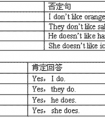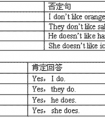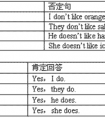写出下列句子的同义句。1.Thisismybook. →Thebookis .2.What'sthenameofyourcity?→ What'syour name?3. Ialwaysgotoschoolonfoot.→ Ialwaystoschool.4. What's-六年级英语
名词所有格用法:
一、’s所有格用法:
1)以s结尾的复数名词直接加“ ' ” 其余加“ 's ”
2)以s结尾的人名加“ ' ”或加“ 's ”
例如:Have you read Robert Browning’s poems?你读过罗伯特-勃郎宁的诗吗?
二、of 所有格用法:
凡不能加’s的名词,都可以与of构成短语,来表示所有关系。无生命名词的所有格也可以这么用。
例如:Does anyone know the title of the novel?有谁知道这部小说的名字?
There is a tall maple tree at the end of the road.在这条路的尽头有一棵高高的枫树。
但有特殊情况:
This is a photo of my parents.
如果名词后面有一个较长定语,尽管名词表示有生命的东西,也可以用这种所有格形式。
例如:Did you listen to the speech of the President Clinton over the radio?你听了克林顿总统的广播讲话了吗?
They have the support of the people of the developing countries.他们得到发展中国家人民的支持。
三、双重所有格:
所谓“双重所有格(double genitive)”,是指名词所有格或名词性物主代词同of构成的所有格,即“of+名词所有格”。
双重所有格有以下几个特征:
1)“of+名词所有格”中的名词必须表示人,不能表示事物。因此,我们可以说:
a play of Shakespeare’s(莎士比亚的一个戏剧), a friend of my wife’s(我妻子的一个朋友),但却不能说a funnel of the ship’s或 a leg of a table’s,
而且该名词必须是特指的,不能是泛指的。
我们可以说:a friend of the doctor’s(这位医生的一个朋友),a novel of the writer’s(那位作者的一部小说),而不能说a friend of a doctor’s或 a novel of a writer’s。
2)除了修饰的原因外,用双重所有格主要是由于被修饰词有排他性的限定词。
如冠词、某些不定代词、指示代词、疑问代词、数词等。
比如我们不能说 an our old acquaintance,而必须说an old acquaintance of ours(我们的一个老相识);
不能说many their books,正确的说法是 many books of theirs(他们的许多书)。
3)注意区别下列四种表达方式含义的差别:
one of my brother’s friends(明确表示我兄弟有一个以上的朋友)
a friend of my brother’s(暗示我兄弟有一个以上的朋友)
a friend of my brother(对我兄弟有好感的人)
my brother’s friend(我兄弟唯一的一个朋友或刚谈及的那一个朋友)
四、特殊所有格:
若一样东西为两人共有,则后一个人名用所有格;如果不是两人共有,而是各有各的,则两个名词都用所有格,且其后名词应为复数。例如:
The woman dressed in blue is Mary and Alice’s mother.
那个穿蓝衣服的妇女是玛丽和爱丽丝的母亲。
You should find what the difference between Mr. Smith’s and Mr.Black’s cars is.
你应当发现史密斯先生与布莱克先生的汽车的不同之处。
考点名称:动词不定式
- 不定式定义:
由to+动词原形构成。不定式是一种非限定性动词。而非限定动词是指那些在句中不能单独充当谓语的动词,可分为不定式,动名词,现在分词和过去分词。
“动词不定式”由动词+不定式构成。动词不定式在句中可以作句子除谓语之外的任何句子成分。动词不定式的被动形式除了一般形式外还有其完成式和进行式。
常见的有:like / love,want,need,ask,help等。
例:I like to play with Tom. 我喜欢和汤姆玩。
I want to play with Tom. 我想和汤姆玩。
I like to eat dumplings. 我喜欢吃饺子。 - 动词不定式一般结构:
疑问词who,what,which,when,where,whether,how后可接不定式构成不定式短语,在句中作主语、宾语、表 语等。如:
①When to leave for London has not been decided yet. (不定式在句子中做主语)
②Mr. Smith didn't know whether to leave or stay there. (不定式在句子中做宾语)
③I asked Professor Xu how to learn English well. (不定式在句子中做直接宾语)
④The question was where to get the medicine needed. (不定式在句子中表语)
以上例句中疑问词+不定式部分,均可转换为相应的从句形式。如:
①When we shall leave…
③…how I could learn…
经常在这种结构中使用的动词有:
consider,decide,discover,explain,find out,forget,hear,know,lea rn,observe,understand,wonder等。 - 动名词与不定式的区别:
1 动名词与不定式的区别:
动名词表达的是:状态,性质,心境,抽象,经常性,已发生的
不定式表达的是:目的,结果,原因,具体,一次性,将发生的
2 接不定式或动名词,意义相同。
3在下列情况下,一般要用不定式:
①hate,like,love前有would(should)时,
如:I'd like to have a cup of coffee.
②当谓语动词begin,continue,start等是进行式时,
如:Thestudents are starting to work on the di fficult maths problem.
③begin,continue,start与know,understand等状态动词连用时,
如:I soon began to understand what was happening.
④.advise,allow,encourage,forbid,permit等动词后接动名词作宾语,或带不定式作宾语补足语。如:
Our teachers don't permit our/us swimming in the lake.
Our teachers don't permit us to swim in the lake.
4 部分动词后接不定式或动名词时,意义差别较大,应根据句子语境选择使用。
forget,remember,regret后接不定式,表示现在或未来的动作,接动名词表示动作已经发生。如:
Don't forget to post the letter for me.
Have you forgotten meeting her in Beijing Airport?
Remember to close the windows before you leave.
I remember writing him a letter a year ago.
We regret to tell you that all of you are not invited toattend the meeting.
They regretted ordering these books from abroad. - 省to的动词不定式:
(1)情态动词( 除ought 外,ought to意思是“应该”,是情态动词,只有一种形式,后边接动词不定式,to不能省略。
ought to没有人称和数的变化,后接动词原形可以表示现在、将来或过去将来,由时间状语或上下文决定。例如:
They ought to come tomorrow.他们明天应当来):
(2)使役动词 let,have,make:
(3)感官动词see,watch,look at,notice,observe,hear,listen to,smell,feel,find 等后作宾补,省略to。
注意:在被动语态中则to 不能省掉。
在使役动词中get除外(get sb. to do sth.)
I saw him dance.
=He was seen to dance.
The boss made them work the whole night.
=They were made to work the whole night.
(4)表示个人意愿或倾向的would rather,had better,might(just) as well:rather than置于句首时。
Rather than ride on a crowded bus,he always prefers to ride a bike.
(5)Why… / why not…:
(6)help 可带to,也可不带to,help sb (to) do sth:
(7)but和except:but前是动词do时,后面出现的动词用不带to的动词不定式。
(8)由and,or和than连接的两个不定式,第二个to 可以省去:
(9)通常在discover,imagine,suppose,think,understand等词后,可以省去to be:
He is supposed (to be) nice. 他应该是个好人。
(10)but作介词,后接不定式结构时,前面谓语动词部分若含有do的形式时,but后的不定式要省去to,否则要带to。
He wants to do nothing but go out.
He wants to believe anything but to take the medicine.
(11)当两个或多个不定时短语由连词and,but或or连接时,后一个或几个不定式符号to常省略。但若表示对比、对照关系时,则不能省略。
He wants to move to France and marry the girl.
The purpose of new technologies is to make life easier,not to make it more difficult.
(12)不定式做表语时,一般要带to,但若主语部分中含有do的各种形式时,符号to可省去。
We've missed the last bus.All we could do now is walk home.
考点名称:实义动词
实义动词:
与系动词是相对的,系动词亦称连系动词,作为系动词,它本身有词义,但不能单独用作谓语,后边必须跟表语(亦称补语),构成系表结构说明主语的状况、性质、特征等情况。
实义动词意思完全,能独立用作谓语。
实义动词有及物动词和不及物动词(及物动词是指后面要求有直接宾语的动词;
不及物动词指后面不需要跟宾语的动词)即行为动词,表示动作的动词。
实义动词(又称行为动词):表示行为或状态,有完全的词义,能独立作谓语。
如:I go to school by bus. 我乘公交车去上学。
The students clean their classroom every day. 学生每天打扫教室。
- 最新内容
- 相关内容
- 网友推荐
- 图文推荐
| [家长教育] 孩子为什么会和父母感情疏离? (2019-07-14) |
| [教师分享] 给远方姐姐的一封信 (2018-11-07) |
| [教师分享] 伸缩门 (2018-11-07) |
| [教师分享] 回家乡 (2018-11-07) |
| [教师分享] 是风味也是人间 (2018-11-07) |
| [教师分享] 一句格言的启示 (2018-11-07) |
| [教师分享] 无规矩不成方圆 (2018-11-07) |
| [教师分享] 第十届全国教育名家论坛有感(二) (2018-11-07) |
| [教师分享] 贪玩的小狗 (2018-11-07) |
| [教师分享] 未命名文章 (2018-11-07) |

![John _____________ an air-conditioner in _____________ bedroom.[ ]A. have, himB. has, hisC. has, he-五年级英语](http://www.00-edu.com/d/file/ks/4/1/23/2019-08-16/small54858f2c11067f43b6431ea11c99345f1565909294.png)


![What's his name? ____________ name is Li Ming. [ ]A. HisB. Her-三年级英语](http://www.00-edu.com/d/file/ks/4/1/23/2019-08-16/smallbf3f2eef41637228ad7cb0082b827bb31565909431.jpg)

